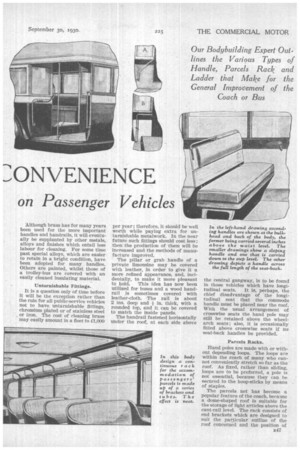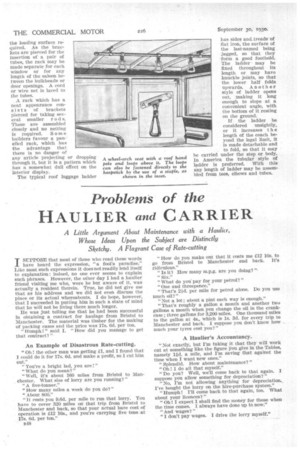Making for
Page 72

Page 73

Page 74

If you've noticed an error in this article please click here to report it so we can fix it.
SAFETY, COMFORT AND
'ONVENIENCE
on Passenger Vehicles
Our Bodybuilding Expert Outlines the Various Types of Handle, Parcels Rack and Ladder that Make for the General Improvement of the Coach or Bus
ALTHOUGH they may at first sight seem to be quite unimportant items of equipment, handles have a considerable bearing upon the comfort and convenience that are provided by the passenger vehicle. Such fittings assume greater significance when applied to buses rather than coaches, because in the former type of vehicle they are likely frequently to be used when it is in motion.
The Ascending Handle.
A rear-entrance bus, such as a double-decker, has an ascending handle attached to the framework of the near-side panel of the bulkhead. Usually it is fastened at the corner, about 1 ft. 6 ins, above the platform, and then it rises, either vertically or diagonally, to the belt panel, along which it passes, and then rises up the standing pillar at the side of the entrance for another 8 ins, or so.
This upper portion of the handle may be omitted, probably because it is considered that it reduces the width of the entrance too much. Its value is, however, at once apparent if one travels on a bus which is not thus equipped. It will be seen that the passengers are continually making use of the body pillar at the entrance as a hand-hold. The pillar soon becomes soiled, and it does not afford so safe a grip as does a wellarranged handle.
A handle of this type should not be less than 1 in. in diameter and should clear the panel by at least 11 in. A good standard measurement to adopt is 11ei& tubing with a full 2-in. clearance.
The upright stanchion, which is centrally disposed on a wide rear platform, has the advantage that it is adapted to the height of any pas
senger----even the smallest child. It is not only a good safety-device and a means for separating two streams of passengers, but it also helps to support the roof.
Recently there has been a tendency to discard these poles as an inside handle, both in single-deckers and in the lower saloons of doubledeckers, with the idea, no doubt, of enhancing the roomy appearance of the interior.
The pole forms a small obstruction in the cross-gangways and its lower end has to be bent so as to follow the shape of the seat-back. On the other hand, the obstruction is really negligible when the poles are fitted only at alternate seats, and such stanchions form much safer and easier hand-holds than do the seatback handles which are used in conjunction with them.
An upright pole may also be used at the end of a longitudinal seat or employed to divide it. The stanchion, with a cross-rail socketed to it at the waist level, then forms a skeleton bulkhead. Alternatively, the handle may be mounted directly in line with a seat-division rail.
Seat-back handles are necessary, because a pole cannot be fitted at each seat corner. The handle which rises above the general level of the back is easier to grasp, although it may not have the neat appearance of a handle which is let into the seatback and does not increase its overall height.
The Seat Handle's Utility.
It is suggested that the utility of the seat handle might be increased if it were continued along the back for its full length. To give it rigidity it would be supported in the centre. It could then be used by the passengers as a means for assisting them along the cross-gangways or for rising from their seats. Such a rail would be similar to the rug rails used in coaches, but it would project above and behind the seat.
Although brass has for many years been used for the more important handles and handrails, it will eventually be supplanted by other metals, alloys and finishes which entail less labour for cleaning. For some time past special alloys, which are easier to retain in a bright condition, have been adopted for many handles. Others are painted, whilst those of a trolley-bus are covered with an easily cleaned insulating material.
Untarnishable Fittings.
It is a question only of time before It will be the exception rather than the rule for all public-service vehicles not to have untarnishable fittings, chromium plated or of stainless steel or iron. The cost of cleaning brass may easily amount in a fleet to £1,000 per year; therefore, it should be well worth while paying extra for untarnishable metalwork. In the near future such fittings should cost less ; then the production of them will be increased and the methods of manufacture improved.
The pillar or grab handle of a private limousine may be covered with leather, in order to give it a more refined appearance, and, incidentally, to make it more pleasant to hold. This idea has now been utilized for buses and a wood handrail is sometimes covered with leather-cloth. The rail is about 2 ins, deep and in. thick, with a rounded top, and it can be covered to match the inside panels.
The handrail fastened horizontally under the roof, at each side above the central gangway, is to be found in those vehicles which have longi tudinal seats. It is, perhaps, the chief disadvantage of the longitudinal seat that the commode handle must be placed near the roof. 'With the usual arrangement of crosswise seats the hand pole may still be retained above the wheelarch seats ; also, it is occasionally fitted above crosswise seats if no seat-back handles be provided.
Parcels Racks.
Hand poles are made with or without depending loops. The loops are within the reach of many who cannot conveniently stretch so far as the roof. As fixed, rather than sliding, loops are to be preferred, a pole is not essential, because they can be secured to the hoop-sticks by means of staples.
The parcels net has become a popular feature of the coach, because a dome-shaped roof is suitable for the storage of light articles above the cant-rail level. The rack consists of end brackets which are designed to suit the particular outline of the roof concerned and the position of the loading surface required. As the brackets are pierced for the insertion of a pair of tubes, the rack may be made separate for each window or for any length of the saloon between the bulkheads or door openings. A. cord or wire net is laced to the tubes.
A rack which has a neat appearance consists of brackets pierced for taking several smaller r o d s. These are assembled closely and no netting is required. Some builders favour a panelled rack, which has the advantage that there is no danger of any article projecting or dropping through it, but it is a pattern which has a somewhat dull effect on the interior display.
The typical roof luggage ladder has sides and.treads of flat iron, the surface of the last-named being jagged, so that they form a good foothold. The ladder may be fixed throughout its length or may have knuckle joints, so that the lower half folds upwards. Another style of ladder opens out, making it long enough to slope at a convenient angle, with the bottom of it resting on the ground.
If the ladder be considered unsightly, or it increases t It e length of the coach beyond the legal limit, it is made detachable and to fold, so that it may be carried under the step or body. In America the tubular style of ladder is preferred. With this any length of ladder may be assembled from tees, elbows and tubes.




















































































































